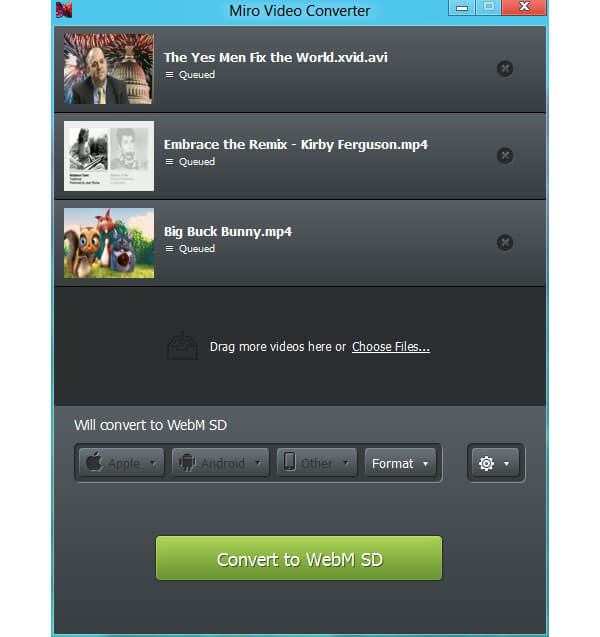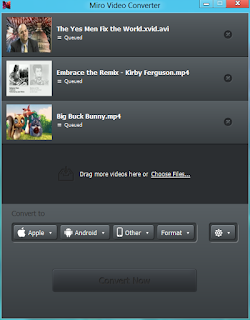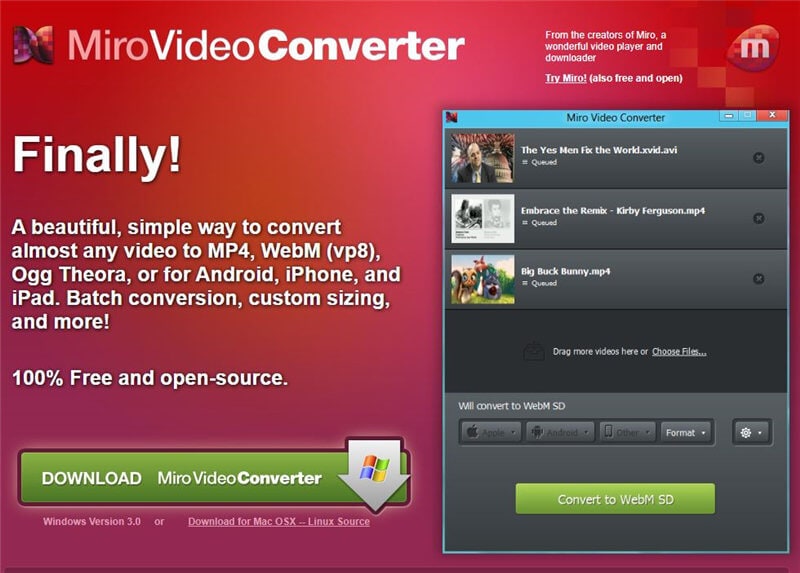

Removing Miro Video Converter apps is more than just moving them to the Trash - it’s completely uninstalling them.

When you’re done installing the application, it’s a good idea to unmount the DMG in Finder. But Applications is the most convenient place to put things, so we suggest you just put everything there.ĭMG files are mounted by your system, like a sort of virtual hard drive. Some people create a “Games” directory, to keep games separate from other applications. You don’t have to put your programs in the Applications folder, though: they’ll run from anywhere.
Now, enjoy Miro Video Converter for MAC !. Then you can feel free to delete the original DMG file: you don’t need it anymore. When you’re done installing: just click the “Eject” arrow. And you’re done: the Miro Video Converter is now installed. Simply drag the application’s icon to your Applications folder. Often these will include the application itself, some form of arrow, and a shortcut to the Applications folder. Double-click the DMG file to open it, and you’ll see a Finder window. dmg installation file from the official link on above First, download the Miro Video Converter. Like if you wanna download Miro Video Converter for mac from this page, you’ll directly get the. Most Mac OS applications downloaded from outside the App Store come inside a DMG file. And it’s all wrapped up in an incredible new UI!. Some additional output options for video developers. Improved WebM output quality with SD and HD options. Output of progressive MP4 files for web playback. Better control for output size and aspect ratio. Just convert your video and copy it to your device This is more common when working over a wireless connection.Miro Video Converter has presets that will convert video to the correct sizes and formats for popular phones, iPods, and other media players. One blip in their Internet connection and they have to start the upload again. We have seen people have some trouble with uploading larger files. We wanted to quickly note that when uploading videos it is best practice to do so over a very strong Internet connection. Other Notes on Video Uploads: Internet Connection Email support a copy of the file with your questions and we will have our tech team take a look. That said, we cannot guarantee that this will work, so we are on standby for you at our office. This can clean up the file a bit and make life easier. Even if your video file is an MP4 or your audio is an MP3, if you have trouble uploading the video, try converting it once again. We have also seen that some files that have been slightly corrupted, or damaged may be fixed when converted. You can now save it to any of the files on your computer and get ready to upload it into Dedoose. Once the video is 100% converted click on the ‘Show File’ link to open it on your computer. Step 4: Save the file and prepare to upload the video into Dedoose Once you select the format, the button on the bottom of the pop up labeled ‘Convert to MP4’ will turn green. Now that the video file has been chosen click on ‘Format.’ Then, select ‘Video’ and finally click on ‘MP4’ as shown below. Click on ‘Choose Files’ to pick the files you wish to convert. When you open Miro Video Converter you will see something that looks like this. Step 2: Open the file you wish to convert Here is the link where you can download the Miro Video Converter. Step 1: Download Miro Converter if you have not done so already It was emailed from the iPhone and saved on a local computer to be converted and imported into Dedoose. The video that needs to be uploaded was shot on an iPhone so it is not in the proper format. So…what exactly do I do if I don’t have an MP3 or MP4 file? The bitrate should be no higher than 1.2Mbps. Video: MP4Video Tip (for the techy types): We recommend encoding to MP4 file format with x264 as the video codec and AAC or MP3 as the audio codec. This converter will help take any file you have and convert it into the only two formats accepted into Dedoose: Thanks to Participatory Culture Foundation, there is an open source tool for video and audio conversion available online. So, how about a free tool that will make all this file conversion business easier? Yes please! And most of the time the problem is that the video is in the wrong format and needs to be converted. One of the most common issues Dedoosers face when working with video and audio in their qualitative data analysis is actually uploading the file. If this Dedooser listed above sounds familiar… as in, it could have been you calling in, never fear. 
The conversation went a little like this…ĭedooser: Hi, I can’t get my video file to upload at all and need some help.ĭedoose Support: I am happy to help you with this. Once upon a time, a Dedooser called Dedoose Support about trouble uploading a video for their qualitative data analysis.







 0 kommentar(er)
0 kommentar(er)
